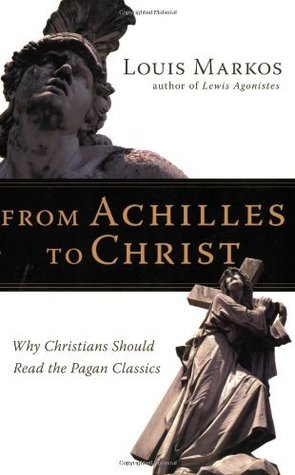More on this book
Kindle Notes & Highlights
Started reading
September 2, 2017
he is not far from us, that in him we live and move and have our being, then it must also be true that those timeless works of ancient Greece and Rome that record the musings of humanity's greatest seekers and yearners will contain traces, remnants and intimations of that wisdom which made us.
As H. Richard Niebuhr has shown in his illuminating study Christ and Culture (1951), the Roman Catholic church has a strong tradition of viewing Christ and Christianity as representing the culmination and fulfillment of both the Old Testament law and the highest wisdom of the ancients-Christ over culture, to use Niebuhr's memorable phrase.
did not survive well the Protestant Reformation.
I would argue that much Christian (especially evangelical) suspicion surrounding the study of the Greeks and Romans can be traced back to the fat...
This highlight has been truncated due to consecutive passage length restrictions.
Thomistic syn...
This highlight has been truncated due to consecutive passage length restrictions.
In his well-known debate with Erasmus (one of Niebuhr's prime exemplars of Christ over culture) on the freedom of the will, Luther demonstrated a resistance to learning anything of spiritual and theological value from pagan philosophy and mythology. Holding fast to an extreme version of the doctrine of total depravity, Luther denies to unregenerate pagan ...
This highlight has been truncated due to consecutive passage length restrictions.
free choice,
Were we not all created in God's image, and though we are all fallen from our original state, does not a spark of divine fire remain in each of us?
Luther was a classical humanist; The Bondage of the Will boasts no less than two dozen carefully chosen and subtly used references from such pagan writers as Cicero, Horace, Virgil, Cato, Ovid and Homer.
Tertullian would have applauded a theological paradigm that sharply distinguished darkness from light, truth from error, grace from wrath.
Saint Jerome, who gave us the Vulgate, would also have praised this approach and would have resisted the notion that the pagan writers could teach Christians anything of spiritual value. Even Augustine himself-who, before his conversion, was a follower of the dualistic Manicheans-would most likely have positioned himself closer to Luthe...
This highlight has been truncated due to consecutive passage length restrictions.
For when the Gentiles, which have not the law, do by nature the things contained in the law, these, having not the law, are a law unto themselves:
Which shew the work of the law written in their hearts, their conscience also bearing witness, and their thoughts the mean while accusing or else excusing one another. (Romans 2:14-15)
The Zoroastrian magi, who visited Christ under the star of Bethlehem, were among those Paul may have had in mind.
You [Virgil] were the lamp that led me from that night. You led me forth to drink Parnassian waters;
For in him we live, and move, and have our being; as certain also of your own poets have said, For we are also his offspring. (Acts 17:26-28)
Aratus and Epimenides, respectively.
Indeed, Paul's use of these pagan verses, along with the line of continuity he draws from the altar to the unknown God to the God known in Christ, parallels his treatment of Old Testament characters, events and verses as types of a greater revelation to come.
The same reason that we look diligently into the Old Testament for glimpses into the truth of Christ's coming and the Gospel, we can look into true pagan literature for the same. That seems to be what Paul understood in Acts 17.
Eleusinian mysteries.
the city of Eleusis
To me it is clear that Jesus constructed this brief but provocative parable specifically for these Greeks as an attempt to communicate with them directly, to build a bridge from myth to doctrine. It is possible that Jesus is doing here the same thing Paul does in his speech before the Areopagus: proclaiming himself as the embodiment of what they have until now worshiped in ignorance.
Having come this far, the Greeks needed only to be nudged by Jesus into a saving knowledge of the one who is more than a dying god or goddess: one who is, in fact, God dying.
regardless of whether it was inspired by Greek or...
This highlight has been truncated due to consecutive passage length restrictions.
In Dublin in 1852, Newman delivered a series of nine discourses intended to set the tone for a proposed Catholic university in Ireland. These discourses represent, to my mind, the finest modern attempt to unite the twin legacies of Athens and Jerusalem. Though the university was never built, the discourses were published as The Idea of a University, and in this form they continue to beckon believers in the Christian revelation to consider the legacy of the ancients.


